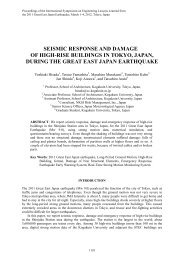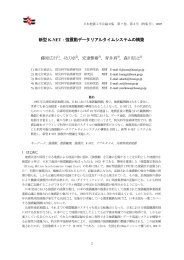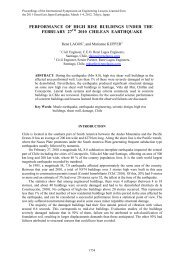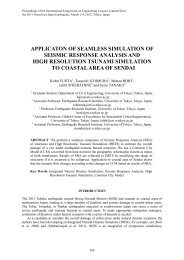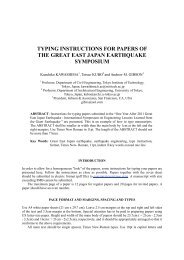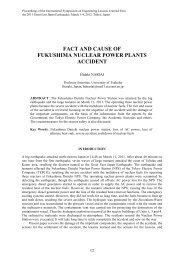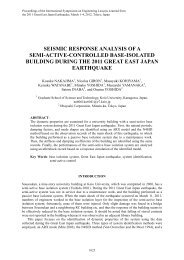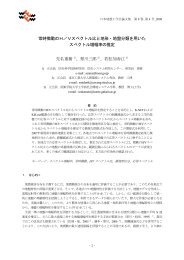The Characteristics of the Triggered 2011 Van-Edremit Earthquake ...
The Characteristics of the Triggered 2011 Van-Edremit Earthquake ...
The Characteristics of the Triggered 2011 Van-Edremit Earthquake ...
You also want an ePaper? Increase the reach of your titles
YUMPU automatically turns print PDFs into web optimized ePapers that Google loves.
Fig. 5 Comparison <strong>of</strong> <strong>the</strong> acceleration records and <strong>the</strong>ir acceleration response spectra on soil(VNKEA) and rock (VNS) stations in <strong>Van</strong><strong>The</strong> comparison <strong>of</strong> raw acceleration records and <strong>the</strong>ir acceleration response spectra indicated that<strong>the</strong> amplifications were 2.4 and 3.6 times, respectively. Fur<strong>the</strong>rmore, <strong>the</strong> maximum spectralaccelerations roughly correspond to those <strong>of</strong> periods <strong>of</strong> 0.36-0.4 s, which generally corresponds to <strong>the</strong>natural periods <strong>of</strong> 6-8 story reinforced concrete buildings.Fig. 5 shows <strong>the</strong> attenuation <strong>of</strong> strong motions recorded by <strong>the</strong> ERD and KOERI with <strong>the</strong>empirical relations <strong>of</strong> Aydan (2001), Aydan and Ohta (<strong>2011</strong>a) and Ulusay et al. (2004). <strong>The</strong> maximumground acceleration on soil is well predicted by <strong>the</strong> attenuation relation proposed by Aydan (2001)while <strong>the</strong> relations by Aydan and Ohta (<strong>2011</strong>a) using <strong>the</strong> shear velocity <strong>of</strong> <strong>Van</strong> strong motion stationand Ulusay et al. (2004) underestimated <strong>the</strong> maximum ground accelerations by 30-40% less.One <strong>of</strong> important observations in Fig. 5 is <strong>the</strong> effect <strong>of</strong> <strong>the</strong> fault orientation. While <strong>Edremit</strong>station is on <strong>the</strong> stationary or footwall, <strong>Van</strong> station is on <strong>the</strong> mobile or hanging wall side. <strong>The</strong>maximum ground accelerations are almost same, <strong>the</strong> distances <strong>of</strong> <strong>the</strong> <strong>Edremit</strong> and <strong>Van</strong> strong motionstations to <strong>the</strong> fault are 4 and 12 km, respectively. This fact also illustrates <strong>the</strong> fundamental reason forseemingly scattering <strong>of</strong> observed data when spherical and cylindrical attenuation relations areemployed.Aydan and Ohta (<strong>2011</strong>a) improved <strong>the</strong> attenuation relations <strong>of</strong> Aydan (2007) by considering <strong>the</strong> dipangle and fault length also. <strong>The</strong> attenuation relations <strong>of</strong> Aydan and Ohta (<strong>2011</strong>a) for maximum groundvelocity are compared in Fig. 5. <strong>The</strong> computed maximum ground velocity values at <strong>Edremit</strong>, Muradiyeand Bitlis are well estimated by <strong>the</strong> attenuation relations <strong>of</strong> Aydan and Ohta (<strong>2011</strong>a). However, <strong>the</strong>observed value <strong>of</strong> <strong>Van</strong> strong motion station is somewhat higher than <strong>the</strong> estimations when <strong>the</strong> shearwave velocity (V s30 ) <strong>of</strong> 363 m/s is used. <strong>The</strong>refore, <strong>the</strong> concept <strong>of</strong> using <strong>the</strong> shear wave velocity for top30 m ground as <strong>the</strong> representative value <strong>of</strong> site conditions is very questionable. Similar conclusion isvalid for <strong>the</strong> records taken in Japan.1918



